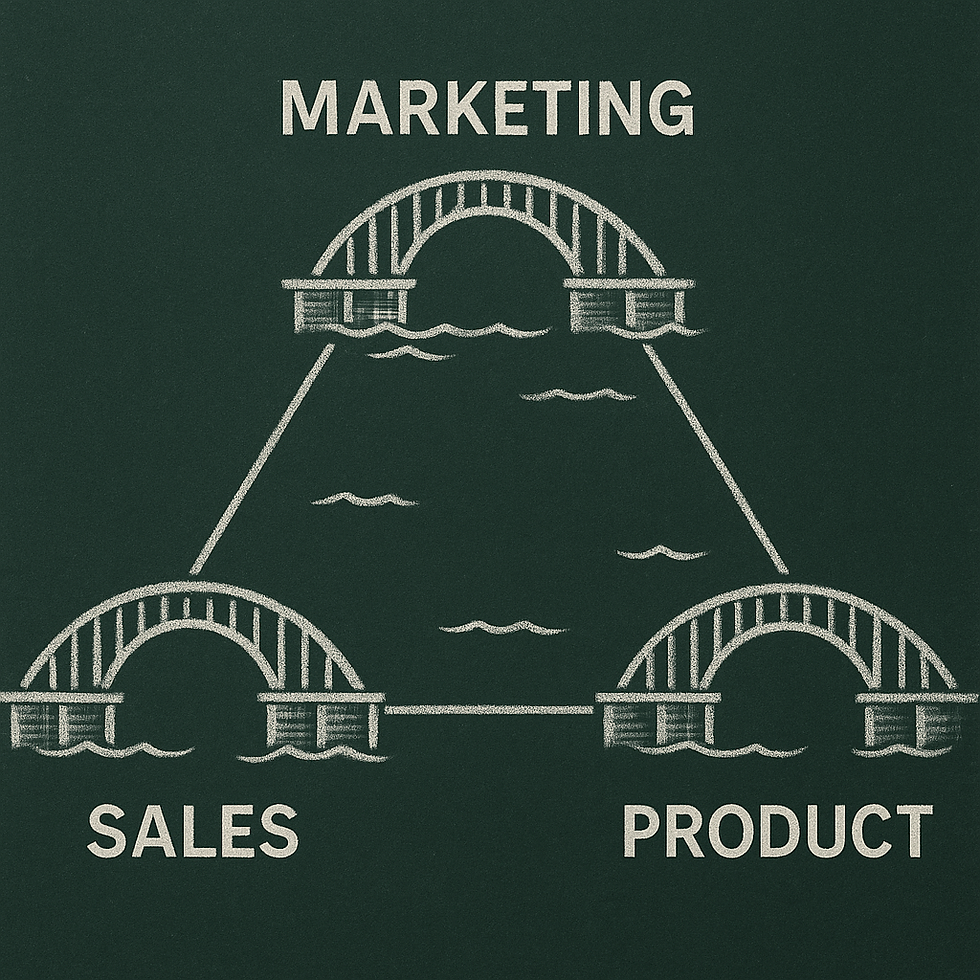The Bermuda Triangle in Your Business: Where Revenue Vanishes Between Teams
- Angel Francesca
- Jul 27
- 4 min read
You're looking at your numbers, and something doesn't add up. Marketing generated a thousand leads. Sales closed twenty deals. What happened to the other 980?
They didn't just say no. They vanished.

They disappeared into the Bermuda Triangle that exists in most companies: the vast, unmonitored space between your marketing, sales, and product teams. This isn't just a minor leak; it's a chasm where your revenue, customer trust, and best ideas are lost forever. The good news? You can chart these dark spaces and build bridges across them.
Mapping the Bermuda Triangle: Where Value Disappears
When your teams operate in isolated silos, they create invisible gaps where value simply vanishes. According to research, this kind of misalignment can cost you dearly—companies with tightly aligned sales and marketing teams achieve 38% higher sales win rates. That’s a lot of revenue disappearing into the fog.
Here are the three most dangerous parts of the triangle:
The Marketing-to-Sales Gap: This is where qualified leads go to die. Marketing, proud of its numbers, throws leads over the wall. But without a shared language or a clear handover protocol, they arrive with no context. Sales, unable to see the value, lets them go cold.
The Sales-to-Product Gap: This is where brilliant customer insights go to die. Your salespeople are on the front line, hearing what customers really want and what their biggest frustrations are. But that priceless feedback never makes it back to the product roadmap, so you end up solving yesterday's problems.
The Product-to-Marketing Gap: This is where your value proposition goes to die. Your engineers build a game-changing new feature, but its purpose and power get distorted as it travels to marketing. The result is a weak, confusing message that fails to connect with customers.
The Rescue Mission: 3 Bridges to Recover Lost Revenue
Closing these gaps requires a deliberate, structured approach. You need to become an organisational engineer and build bridges that can withstand pressure.
Bridge 1: The Bridge of Shared Truth (Collaborative Intelligence).
You can't navigate a dark space without a shared map. Your first bridge is built on data. This means creating a single source of truth that all teams can see and trust. Look at Salesforce. Their entire Customer 360 platform is designed to solve this very problem, giving every team—from sales and service to marketing—the same unified view of the customer so that no one is navigating blind.
Bridge 2: The Bridge of Shared Purpose (Integrated Planning).
Once you have a map, you need a common destination. Stop giving each team a different one. Ditch the conflicting departmental KPIs and create a single ‘One-Page Growth Plan’ for the quarter, co-owned by the heads of sales, marketing, and product. When they are all jointly responsible for the same number—like ‘Qualified Pipeline Growth’—they are forced to build the bridge together.
Actionable Tip: Schedule a recurring "Revenue Team" meeting. This isn't just a sales meeting. It must include leaders from Marketing and Customer Success. The agenda is simple: review progress against shared revenue goals, analyse recent wins and losses together, and plan the next set of commercial activities as a joint team.
Bridge 3: The Bridge of Coordinated Action (Unified Execution).
This is about how traffic flows across your new bridges. It means sales and marketing sitting down to agree on a single, precise definition of a ‘qualified lead.’ It means creating small, dedicated ‘growth pods’ (e.g., a sales rep, a marketer, and a customer success manager) to work together on key accounts, ensuring no communication gets lost in translation.
The Payoff: Turning Black Holes into Goldmines
When you successfully build these bridges, the impact is profound. You don't just reduce friction; you unlock new value. Companies with strong alignment also see 36% higher customer retention rates, because the customer experience becomes seamless. Your business becomes more agile, more innovative, and ultimately, more profitable.
This is precisely where the Sales Supercharger course from ClickAcademy Asia comes in. Think of it as a specialised engineering workshop where your teams learn how to design and construct these revenue-saving bridges. It’s a practical, hands-on programme that equips your team with the frameworks to close the gaps in your own business, from building a collaborative market intelligence report to designing a unified lead qualification process.
For too long, we've focused on optimising the islands—making sales more efficient or marketing more creative. But the biggest opportunities for growth aren't on the islands; they are in the treacherous waters between them.
As a leader, your job is to be the chief navigator. Map the black holes where your revenue is disappearing, and then build the bridges that will carry your business to its destination—safely and together.
Stop Losing Revenue in the Gaps
Leads disappearing? Insights going unheard? It’s time to bridge the gaps between sales, marketing, and product. The Sales Supercharger course from ClickAcademy Asia gives your team the tools to align and execute together—turning black holes into goldmines. With up to 70% SkillsFuture funding, there’s no better time to act.



Business success requires more than innovation; it demands trust, strategy, and customer satisfaction. Companies face constant scrutiny, and online platforms like https://www.pissedconsumer.com/ highlight the importance of addressing customer complaints effectively. Organizations that monitor feedback, adapt to concerns, and maintain transparency can transform criticism into growth opportunities. Strategic planning, ethical practices, and responsive customer service are no longer optional they are essential for sustaining reputation, fostering loyalty, and achieving long-term profitability in competitive markets.